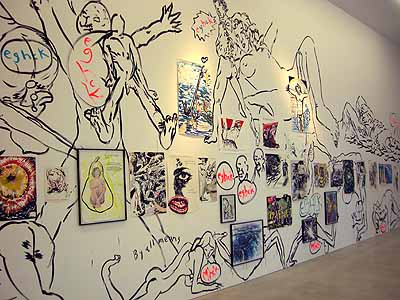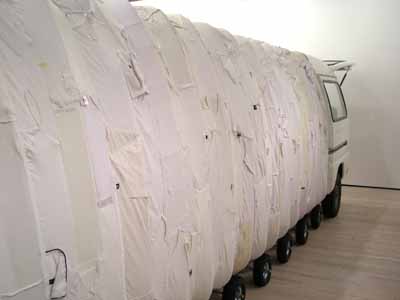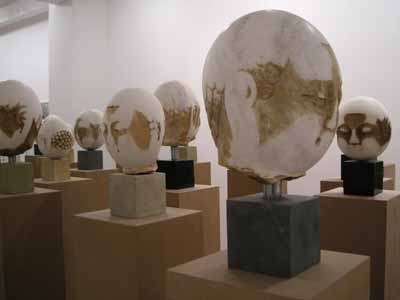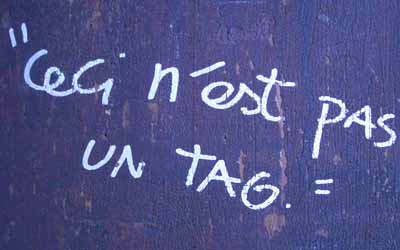
|
||
|
Portland art blog + news + exhibition reviews + galleries + contemporary northwest art
|
||
Report From Berlin by Bean Gilsdorf 
clockwise from top L: Gabriele Basch, keychain from Guggenheim Berlin, Raymond Pettibon, Holocaust Memorial, graffiti, Hamburger Banhof visitors Place is a fundamental concept. There is something about a change in geography and language that reveals to the traveler a whole new way of thinking, a unique aesthetic. "Culture shock" is the relatively pejorative term we use for breaking out of our paradigm of living, but sometimes shock is both essential and welcome; an unfamiliar cultural environment is a wake-up call to those of us operating on autopilot. Like me, you might be sorry to see this perspective cast aside with a dismissive wave in last week's NYT Style Magazine. A Travel Spring 2008 article proclaimed, "Expats in Berlin have turned the city into one big arty party," as though the best reason to go to an international arts hub is for the revelry. But for artists and arts patrons, the best Berlin has to offer isn't the party, but the culture shock. Here are some of the highlights of what I found there last week: 1.) Galleries and museums  Dana Schutz "Shooting in Natural Environments" (2008)  Pettibon's "No Title 2008" installation view Berlin has a surfeit of galleries ranging from blue chip to indie. For premiere galleries, nothing outclasses Contemporary Fine Arts, which is currently showing Dana Schutz and Raymond Pettibon, both of whose work I had only seen in reproductions. It was a treat to see Schutz's paintings in person---with her deft brushwork and art-historical references, it's easy to see why her work garners such praise. For Pettibon, I had previously only seen his work one piece at a time. At CFA the enormous wall paintings with overlaid groupings of smaller works on paper made me reconsider my prior indifference to his oeuvre. The museum-quality space alone, replete with sky-high ceilings and icy staff, is worth the trip.  Gabriele Basch (detail) Other contenders for the Gilsdorf Berlin Prize 2008 were solo shows by Gabriele Basch and Chiharu Shiota. Basch had stunning work at Galerie M + K Fricke, subtle cut and lacquered paper constructions that adroitly navigated the area between drawing, painting, and installation. Each elegant, undulating wall-hung piece was painted white on the front and various colors on the back, so that the backing color reflected off the wall through the holes and around the margins of the piece, making it glow.  Shiota's "Inside-Outside" Shiota, at Goff + Rosenthal, presented two installations in the front and back rooms of the gallery with a grouping of smaller works in between. The standout work in her show was the installation in the front gallery, a dense black cocoon of wool threads that permeated the room like smoke.    Xuizhen's "Collective Unconscious" (2007)  Maoyuan's "Faces (Buddhas)" (2006-2007) Most of the group shows I saw didn't offer much in the way of real stunners, the exception being "Die Wahren Orte" at Alexander Ochs, a gallery specializing in Chinese contemporary art. This exhibition, which promised to change over the course of its tenure, included Yin Xiuzhen's 50-ft. installation of a bus with stitched panels of repurposed clothing from Chinese sweatshops, and Yang Maoyuan's series of ground-down marble Buddha heads, simply entitled "Faces".  Bernhard Leitner, "Variations on a corridor" 1938  a Leitner soundscape in the museum For museums, the Hamburger Bahnhof had "Sound Space Sculpture", a group of Bernhard Leitner's preparatory drawings and photos for soundscapes, with one of the finished works situated in a temporary room in the middle of the main gallery. This show was accompanied in the side gallery by an impressive group of mid-20th c. paintings, and in the adjacent Rieckhall galleries by a vast (and vastly boring) photo exhibition. At Martin-Gropius-Bau, there was "Macht & Freundschaft", a collection of objects and paintings from the early 19th c. celebrating German-Russian power and cultural exchange. Except for a pair of massive heroic bronze sculptures of horse tamers from 1841, the collection didn't ring my bell; however, the bookstore in the museum is, without contest, the best collection of art, architecture, and design books, in English, German, and French, that I have yet to see. Visitors to the MGB bookstore will want to memorize the ever-handy "Kann ich mit Kreditkarte zahlen?" -the German equivalent of "Do you take Visa?" 2.) Street Level   Graffiti in Berlin Of course, the galleries and museums are world-class and far too numerous to go through comprehensively. But a significant factor is that design doesn't stop at their door sills. I never thought I would put the words quality and graffiti together, but there's graffiti everywhere in Berlin, so much so that it's a constant and ever-shifting source of input and response, an ongoing dialog with the high art/commercial scene. Although the great bulk of it is still the standard urban "tag", there were plenty of smart, witty, well-designed bits of graffiti everywhere you looked. And the style is so entrenched that it's come full-circle, with the method being used as a "legitimate" form of mark-making.   Playground equipment in Berlin But something else you might notice is the detail given to the smallest things, or, in this case, the smallest people. Playgrounds in Berlin are as surprisingly well-designed as everything else, eschewing the primary-colored commercial plastic dreck we see in the States for intriguing shapes and forms that look surprisingly similar to what we call public art. In the land of Chucky Cheese-style entertainment for children, it's easy to forget that living with first-rate design on every level informs and feeds quality of life. Is it possible that children who grow up surrounded by superlative design will become better artists than their American contemporaries raised on Bratz? In another twenty years we'll have the answer. 3.) Architecture  The building on the left is pre-WWII; on right, probably about 15 years old But if traveling is about literally stretching your boundaries (as it should be, no matter what the Times says about "a Teutonic bore") the biggest revelation I had was not about art but architecture. After the bombings of WWII, there were precious few buildings left intact, so there's an incredibly wide range of architectural styles in Berlin, from the 1465 Berliner Dom, to Communist housing blocks, to the I.M. Pei-designed German History Museum. However, the most interesting juxtapositions were not between antique and futuristic public works, but between the older and newer edifices of a more workaday sort. And what I discovered in that juxtaposition was this: architecture is public art. Don't mistake it for mere semantics, there's a deep connection to how people live their lives within the confines of a city. Perhaps it's obvious to you, but after a decade of interchangeable garage-door building fronts and rows of condos gleaming like bonded teeth, I had forgotten how much authentic character some good architectural design can add to a city. And the beauty of Berlin is that the buildings are not a homogenized old-Euro backdrop for urban life; rather, the mix of archaic and modern styles shows a great deal of thought and planning at all levels; the juxtapositions aren't ugly and jarring. Architecture in the States---the kind that makes news, anyway---has always struck me as a relentless show of posturing by big names intent on gratifying their egos instead of creating buildings designed to enhance the city and the daily lives of its citizens. If there's anything I really want to take away from my experience of Berlin, it's that we need to stop shaking our pompoms for the so-called cutting edge (no more "Experience Music Project"), and start awarding contracts to architects who are willing to analyze the needs of the city and think about what best suits the space. Bean Gilsdorf is a Portland based multi-media artists Posted by Guest on April 08, 2008 at 19:25 | Comments (4) Comments Thank you for the excellent report from Berlin. And good points about the juxtapoz of architectural styles. Europe seems comfortable with that...old and new, shoulder to shoulder. You give a nice street level feel for the place. And I know my kids would enjoy those playstructures... The question your post brought up for me was if geography means much anymore. I see different places being more receptive to art, but in terms of what's created, locale doesn't seem the overriding factor. The marketplace of ideas has commodified, via the media and web. When I see repros from abroad many of the same devices are there....a little fauve, a little minimalism, a little install, etc... Whether it's Seville or Shanghai. Many of the same battles being fought. Is this art "progression"? or is there just more of it? Intellectual laziness? A hall of mirrors awaiting the next step? This isn't a sarcastic rant, but a real question.... The picture frame has exploded, the notion of art envelopes all manner of medium and technique. So what's left? Just the artist and their myopia? Suppose just open ended questions with no answer. I'm tempted to think it may be time to swing back to the utilitarian roots artists have historically played. We've had 150 years of the artist as navel gazer, now perhaps it's time to apply the skills to the tasks at hand. Creating environments, tackling problems, designing the future. Again, great post on Berlin. Look forward to others if you're running around Europe..... "Lucky!" --- Napoleon Dynamite Thanks for allowing me to comment. Posted by: Sean Casey Sadly, I cannot take any credit for this piece on Berlin and must post a correction. I did go with Bean on the trip but I was stricly on vacation. All of the observation, photography, and writing are hers; I mostly just ate and complained about my sore feet. She and I work collaboratively in the studio on occasion, which can lead to some confusion I suppose, but I am by no means a writer so all tipped hats go to Bean on this one. Posted by: dan gilsdorf Sadly, I cannot take any credit for this piece on Berlin and must post a correction. I did go with Bean on the trip but I was stricly on vacation. All of the observation, photography, and writing are hers; I mostly just ate and complained about my sore feet. She and I work collaboratively in the studio on occasion, which can lead to some confusion I suppose, but I am by no means a writer so all tipped hats go to Bean on this one. Posted by: dan gilsdorf Dan you have been expunged... thanks Bean
Ive been increasingly drawn to that idea... and have really enjoyed travelling in cities with a local guide or 2. As far as stunt architecture... Seattle's EMP is pretty terrible but the same architect, Frank Ghery did a rather incredible job with the Walt Disney Concert Hall in LA... it has an interesting populist element with lots of "open to the public" outdoor spaces... the building is a kind of public park in many ways. All that said you are absolutely right... Portlanders need to get used to the very new existing next to the historic... it makes one appreciate both... faux historic buildings lead to a crappy disneyland experience. Im all for honest buildings. The Shiota is pretty incredible... Museum of Contemporary Craft should do that. It's also interesting how ceryain artists like Schutz and Pettibon turn up in both Berlin and Portland.... still Berlin is different, in the 20's it was the most cosmopolitain city the planet has ever seen. Once again.. thanks Bean Posted by: Double J Post a comment Thanks for signing in, . Now you can comment. (sign out)
(If you haven't left a comment here before, you may need to be approved by
the site owner before your comment will appear. Until then, it won't appear
on the entry. Thanks for waiting.)
|
| s p o n s o r s |
 |
 |
 |
 |
 |
 |
 |
 |
 |
 |
 |
 |
 |
 |
 |
 |

|
Site Design: Jennifer Armbrust | • | Site Development: Philippe Blanc & Katherine Bovee | |


![[TypeKey Profile Page]](http://www.portlandart.net/nav-commenters.gif)